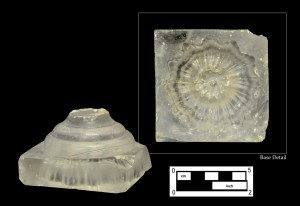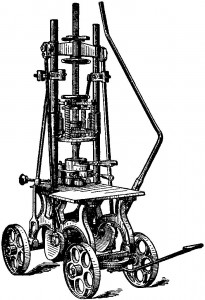The concept of forcing glass into a mold to give it shape is an ancient idea, but tools specifically designed for this purpose developed gradually in the 18th and 19th centuries.
https://www.youtube.com/watch?v=gbhwS5FyToQ&rel=0
Plier Press
From about 1740 to 1900, a two-handled tool, sometimes called a plier press, was used to pinch glass chandelier drops, small stoppers, and toy cup plates.
Hand Press

The hand press came into use in Europe around 1780‒85, but was not used in America until the 1810s or 1820s. Often used to make “feet” or bases for lamps, candlesticks, goblets, and other forms, hot glass was lowered into an open mold and pressed into the form with a hand-held plunger that imparted a decoration on the underside. Today such bases are sometimes called “lemon-squeezer” bases because the plunger usually had a ribbed pattern, making the underside of the glass base look somewhat like the underside of a lemon squeezer. Use of the hand press continued until about 1840 and overlapped with the development of more sophisticated pressing techniques.
Bench Press

The bench press, invented around 1825 or 1826 and used until about 1850, was the first pressing mechanism to use a lever to force glass into a mold. The term “bench press” is a 20th century term used to differentiate this mechanism, which had to be mounted to a table or bench, from the free-standing machine press. Small forms such as furniture knobs, salts and cup plates could be made in the bench press. Union Glass Works in Kensington was one of the first companies to use this technology.
Free-standing Machine Press

The free-standing machine press shortly followed the invention of the bench press. Through the use of a large screw or side arm, the machine press could provide greater vertical pressure and improved alignment of the plunger and the mold, so larger articles could be made.
The bench press and machine press could be operated by two relatively unskilled laborers, one to gather the glass and lower it into the mold, and the other to cut off the gather of glass, close the mold, and pull the lever down to force the plunger into the mold. Another assistant, often a boy, would then carry the finished piece to the annealing oven, where it slowly cooled.
Much pressed glass dating from the mid-1820s to about 1840 has elaborate stippled decoration and is therefore called “lacy pressed” glass. The fancy patterns were designed to hide surface imperfections caused by the pressing technique, as well as the shear mark created when the glass was cut off the gathering iron. When hot glass is pressed into a metal mold, the mold is colder than the glass and causes tiny ripples, called chill marks, on the surface of the glass.
Characteristics of Pressed Glass

Unlike mold-blown glass, one surface of pressed glass usually carries the decoration and the opposite side is very smooth. Except for very shallow open forms, press molds have multiple parts. Seam lines are often apparent where the sections of the mold joined. On some objects, the seams protrude and are quite sharp because the glass was forced into thin crevices between the mold sections. In other cases, the seams may be well integrated into the design or fire polished (slightly heated) to make them smooth and less visible. Also, in determining if an object was pressed or cut, generally the cut decoration will be sharper and have slight irregularities in the design. Molded glass usually has a duller, somewhat textured surface compared to the glossy surface of free-blown glass or polished cut glass.
All of the illustrated artifacts were recovered from the I-95/Girard Avenue Project area in Philadelphia. Videos presented courtesy of The Corning Museum of Glass.
